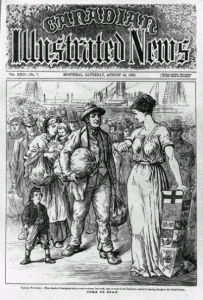Financial Post Addresses Growing Income Disparity Between Recent Immigrants and Other Canadians

1880 poster inviting people to immigrate to Canada. The income gap between recent immigrants and native born Canadians has grown from 20 percent in 1970 to 39 percent today.
The growing income gap between recent immigrants and longer-established Canadians received special news coverage today with a report in the Financial Post by the deputy chief economist of CIBC, Benjamin Tal.
The article describes the deteriorating position of newly arrived immigrants relative to native-born Canadians by comparing what it was in the 1970s to what it is today:
A male immigrant who arrived in Canada in the 1970s made about 80¢ on the dollar relative to a Canadian-born worker, and he was able to narrow the gap at a rate of roughly 1¢ per year. Today, despite the fact two-thirds of newcomers have post-secondary education, their earnings have dropped to close to 60¢ on the dollar and the gap is narrowing at a much slower pace. Nearly half of the individuals who immigrated to Canada between 2001 and 2006 are overqualified for the jobs they occupy.
Tal places a large economic price on the growing income gap, estimating it deprives Canada of $20 billion in earnings a year, and argues that the Canadian economy will need to do better at harnessing the economic potential of its immigrants if it is to make up for the decreasing ratio of Canadian workers to retirees as Canada’s population ages.
The editorial counsels against expanding immigration programs designed to meet Canada’s short term labour market needs by allowing lower skilled workers to become permanent residents, arguing that lower-skilled workers are less able to adapt to changing labour market conditions. It points out that even in the comparatively long-term-focused Federal Skilled Worker Program, one third of the preferred occupations are construction-industry related, and that a slowdown in the housing market could leave immigrants in these vocations lacking the qualifications to work in Canada.
Tal recommends that to address the income gap, the Canadian government should borrow from Australian immigration policy, which manages to keep income disparity between its immigrant and native-born workers at 50 percent the level seen in Canada, and raise language proficiency requirements for immigration.
This is not the first time an economist for a large Canadian bank has recommended increasing the language bar for immigrants. A report by TD chief economist Craig Alexander in February proposed increasing official language proficiency requirements for immigration applicants along with expanding the role of provincial nominee programs in selecting immigrants in order to reduce the income and employment gap between immigrants and native-born Canadians.
Pingback: Canada Top Country for Immigrant Businesses – Financial Post | CICS News – Canada's immigration news source